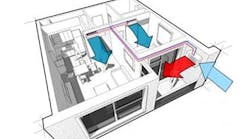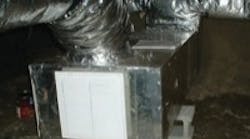By LARRY SAMBROOK
An example of the kind of improper installation we've all seen before, well-suited for the 'wall of shame.'
There can be many excuses for not installing HVAC correctly:
- youth and inexperience
- "the plumber was in the way"
- "the home builder wouldn't let me put it where I wanted to"
- "that was the only way to make it fit."
While many contractors do high quality work, as an industry, much remains to be done to raise the bar on quality.
The infamous "low bid" is always an issue, and can be one reason why some have sacrificed integrity and our customers' health and comfort in an attempt to be the lowest bidder.
Two years ago, in Florida, I saw a contractor advertise a 3-ton air conditioning system "installed" for $1,350. I recently returned to find the same contractor selling the same system for $1,250 and it now has a five year warranty!
Can you beat that price? I should ask, Do you want to beat it? If you were to make a blind judgment of that installation based only on price, what do you think the quality would be?
On the other side of the spectrum there is a heating and air company in Charlottesville, VA that has ridden the quality bandwagon to a 51% share of the market with a simple slogan such as "Installed with Pride". Obviously, they're not competing on price, and their installations are a thing of beauty. I tested some of their systems for duct leakage, and most of them are below 5%. Not only are they beautiful, they also work.
In the commercial HVAC industry, we strive to create comfortable and healthy environments for workers. A recent study of worker productivity showed that based on annual compensation of $51,000 with the average square footage per worker of 225 sq.ft., the cost per worker was $226.67, and a 10% decrease in productivity due to poor indoor air quality (IAQ) was $22.67 per sq.ft.
Next, they looked at 813 different buildings, and determined that 75% of the IAQ problems were due to HVAC system faults, failures, and deficiencies.
Respiratory illnesses afflict more than 70% of all adults, and contribute to 176 million lost work days. William Pape, the founder of Verifone, found that 18 months after relocating into a building specially retrofit to reduce indoor pollutants and improve indoor air quality, the absenteeism among his employees declined 40% and productivity increased 5%.
There are other incentives to raising the bar on quality. We know that better installation practices will increase costs, but how many of us are taking advantage of the Energy Policy Act of 2005?
The Act offers a tax deduction of $1.80 per sq.ft. for commercial buildings that are certified to reduce total annual energy and power costs to 50% of ASHRAE 90.1-2002, and $.06 per sq.ft. for improvements in interior lighting, HVAC, and hot water systems.
Industry Convenes to Raise the Bar
In March 2005, the Air Conditioning Contractors of America (ACCA) held a meeting in Washington, DC. Industry leaders gathered there to discuss the installation practices of our industry and find a way to raise the bar on quality. Every segment of the market was invited: contractors, manufacturers, utilities, government agencies, and many others. Participants from across the country agreed change was needed.
What they realized was that, when they looked for a bar to raise, they discovered there wasn't one. Installing contractors had been using model codes, but the code's intent was to set the minimum acceptable practice for a safe installation, not a quality installation.
Skip Snyder, a contractor and member of ACCA, volunteered to chair this group of industry stakeholders as they sought industry-wide acceptance for an installation standard.
The first step was defining a quality installation, or setting the bar regarding what constitutes a quality installation. It took almost two years to resolve, but after numerous meetings and countless teleconferences, they developed The HVAC Quality Installation Specification for Residential and Commercial HVAC Applications, or as it has come to be known, "QI," for Quality Installation.
Elements of Excellence in QI Program
The QI specification covers the following equipment:
Residential installations
- Unitary air conditioners and air/water-source heat pumps ≤ 65,000 Btuh
- Furnaces ≤ 225,000 Btuh
- Boilers ≤ 300,000 Btuh
Commercial installations
- Unitary equipment (packaged and split) > 65,000 Btuh u Furnaces >225,000 Btuh
- Boilers > 300,000 Btuh
The main elements of the QI specification are:
Correct Installation & Commissioning
- HVAC equipment: sized, selected, installed
- Air distribution: proper design, correctly installed, airtight
Continuing Performance & Maintenance
- Document application and intended operation
- Educate the owner about operation and maintenance (O & M) requirements
- Encourage and promote system maintenance
In addition, the appendices of the QI specification are loaded with recommendations for contractors who want to know the policies and procedures a good business should have.
The QI specification is ultimately aimed at defining the elements of a turn-key quality installation program with appropriate field verification approaches. With this program, utilities could ensure their customers were actually getting the energy efficiency for which they received rebates. Customers would then know they owned comfortable, healthy, safe, and efficient heating and cooling systems.
QI Not a Cure-All
The QI specification will not cure our industry overnight. It will take the hard work of the contractors to raise the level of proficiency for the industry. Contractors will have to do the work. They'll have to show the value, spend the time designing the job, supervise the installation, and verify the job on completion.
Most customers want the job done correctly and are willing to pay a little more when they can see the value. Contractors can use the referrals from these satisfied customers to build a solid business that doesn't compete on price. The QI contractor will see fewer callbacks and lower warranty costs, these savings going straight to the bottom line
The QI specification has been released for national review, so that it can become an American National Standards Institute (ANSI) standard. Energy Star is working with ACCA to incorporate QI into a new home program. A utility in California ran a pilot program to implement the QI standard, and QI is being welcomed by all industry stakeholders, as they work together to raise the bar in the HVAC industry.
Larry Sambrook, CIE, CIEC, CAD, is president of the Indoor Air Quality Network, Staunton, VA. He is certified to teach indoor air quality (IAQ) by the American Institute of Respiratory Education and is a proctor for NATE, the U.S. Department of Energy, and the Environmental Protection Agency. He can be reached at www.iaqn.net










